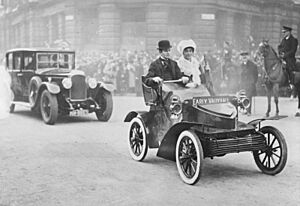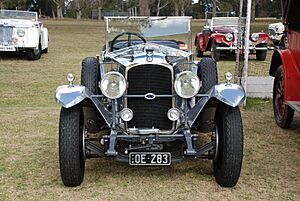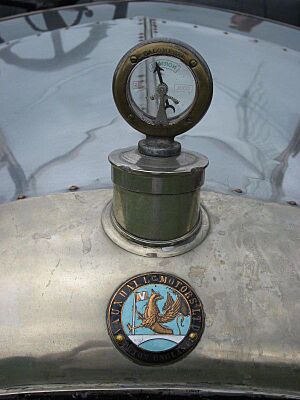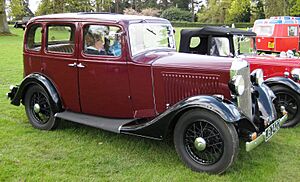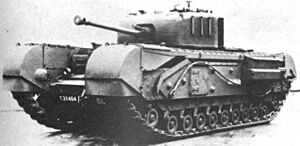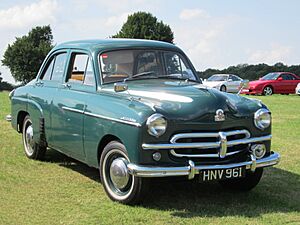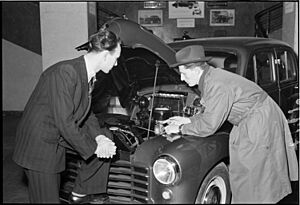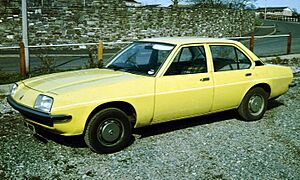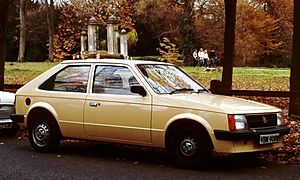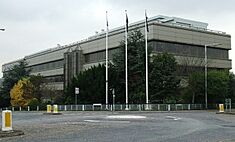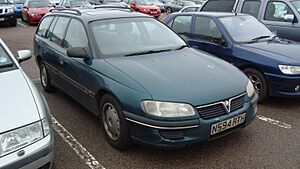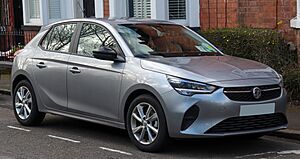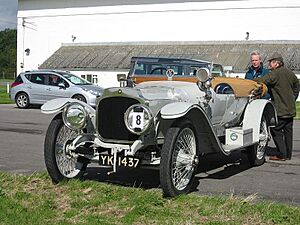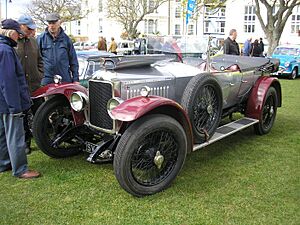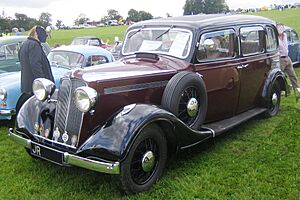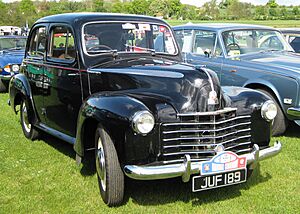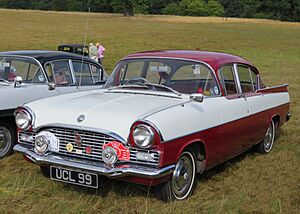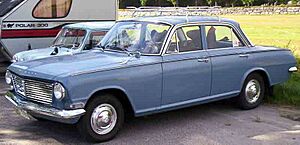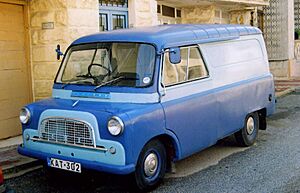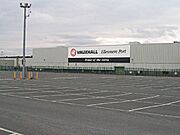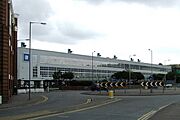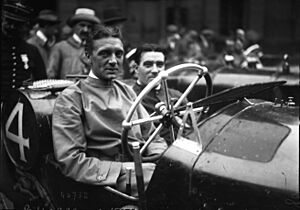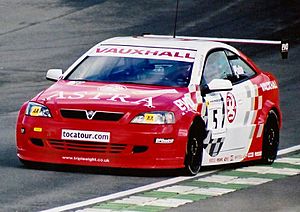Vauxhall Motors facts for kids
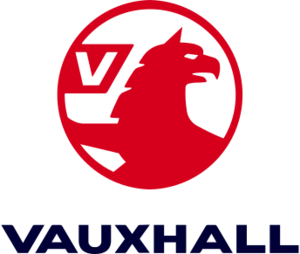 |
|
|
Formerly
|
|
|---|---|
| Subsidiary | |
| Industry | Automotive |
| Founded | 1857 |
| Founder | Alexander Wilson |
| Headquarters |
Coventry, West Midlands, England
|
|
Number of locations
|
One manufacturing facility in the United Kingdom |
|
Area served
|
United Kingdom |
|
Key people
|
James Taylor (MD) |
| Products |
|
|
Production output
|
118,182 (2016 passenger cars) |
| Services | Vehicle financing |
| Revenue | |
|
Operating income
|
|
| Total assets | |
| Total equity | |
|
Number of employees
|
4,029 (2011) |
| Parent |
|
Vauxhall Motors Limited is a British car company. Its main office is in Coventry, England. Vauxhall became part of the PSA Group in 2017. Later, in January 2021, it joined Stellantis, a new company formed by PSA and Fiat Chrysler. Before that, General Motors owned Vauxhall since 1925.
Vauxhall is one of the oldest car makers and sellers in the United Kingdom. It sells cars, electric vehicles, and light vans under the Vauxhall name. In the past, it also sold vans, buses, and trucks under the Bedford brand.
Alexander Wilson started Vauxhall in 1857. At first, it made pumps and marine engines. In 1863, Andrew Betts Brown bought the company and renamed it "Vauxhall Iron Works." They started making cranes. In 1903, the company built its first car and changed its name back to Vauxhall.
General Motors bought Vauxhall in 1925. Vauxhall used to make luxury cars, but GM started making cars for the general public. Since 1980, Vauxhall cars have been very similar to those made by Opel, GM's German brand. Most models are designed in Germany.
Vauxhall has one factory in Ellesmere Port that makes commercial vehicles. It used to have another factory in Luton, which closed in April 2025. Vauxhall cars are also made in other Stellantis factories across Europe.
Today, Vauxhall sells popular cars like the Astra (a small family car), Corsa (a supermini), Mokka (a small SUV), and Grandland (a compact SUV). They also have high-performance versions called GSe models.
Contents
- Vauxhall's Journey: A History
- Vauxhall's Current Car Lineup
- Past Vauxhall Models
- Vauxhall's Factories and Operations
- The Vauxhall Logo
- Sponsorships
- Vauxhall in Motorsports
- Images for kids
- See also
Vauxhall's Journey: A History
Early Days (1857–1925)
A Scottish engineer named Alexander Wilson started Vauxhall in London in 1857. The company was first called Alex Wilson and Company. They built pumps and engines for boats.
In 1903, Vauxhall made its first car. It had a small five-horsepower engine and was steered with a handle, not a steering wheel. It had two forward gears but no reverse. About 70 of these cars were made. In 1904, they improved the car with a steering wheel and a reverse gear.
To grow bigger, the company moved most of its production to Luton in 1905. The company was still called Vauxhall Iron Works until 1907, when it officially became 'Vauxhall Motors'.
A young designer named Laurence Pomeroy helped Vauxhall a lot in its early years. He joined in 1906. In 1908, he designed an engine for a car that did very well in a big race, showing great speed and hill-climbing ability. This car was so good that Pomeroy became the chief designer.
His first design, the Y-Type Y1, was a huge success. It led to the Vauxhall A-Type, which could go up to 100 miles per hour. This made it one of the most famous cars of its time.
During World War I, Vauxhall made many D-type cars. These were used as staff cars for the British army. After the war, the company struggled to make money because expensive luxury cars were not in high demand. Vauxhall then started looking for a big partner to help them.
Joining General Motors (1925–2017)
The Early GM Years (1925–1939)
On November 16, 1925, General Motors (GM) bought Vauxhall. GM wanted Vauxhall to make more affordable cars for many people.
In 1930, Vauxhall introduced the low-cost Vauxhall Cadet. The next year, they launched the first Bedford truck, which was based on a Chevrolet design. The Cadet was the first British car to have a synchromesh gearbox, which made changing gears smoother.
GM wanted Vauxhall to make modern cars with good technology at a fair price. In 1933, they launched the Vauxhall Light Six. This car had an all-steel body and a modern engine. It was much cheaper than many older cars, and Vauxhall sold 26,000 of them in just over a year. The factory in Luton even started working 24 hours a day to keep up with demand. Vauxhall quickly became a major car maker in Britain.
In 1937, Vauxhall released the H-type 10-4. This was the first British saloon car to use a "unibody" design, where the body and frame are one piece. This made the car lighter and stronger. It also had modern features like hydraulic brakes. The 10-4 was very popular and sold over 50,000 units.
The Second World War started in 1939, which stopped car sales. By May 1940, Vauxhall stopped making cars completely to help with the war effort.
War and Post-War (1940s)
During World War II, Vauxhall's factory in Luton stopped making cars. Instead, they built Churchill tanks. They went from designing the tank to building it in less than a year. Vauxhall made over 5,600 Churchill tanks. The Luton factory also produced about 250,000 trucks for the war.
Vauxhall was one of the first British car makers to start making civilian cars again after the war. This was easy because their Bedford trucks, used by the military, could be sold to the public. Car production started again in September 1945.
The first post-war cars were similar to the models from before the war. In 1948, Vauxhall launched new models called the Wyvern and the Velox. These cars had a new, modern look, similar to Chevrolet cars in America, but were smaller. The Velox, with its powerful engine, was known for good performance.
The Fifties (1950s)
In 1951, Vauxhall introduced the E-Type models, the EIX Wyvern and the EIP Velox. These cars were much larger and had a new, full-width design. They offered more space inside and were quieter.
By 1953, Vauxhall was building 110,000 E-Type cars each year. About half of these were sold to other countries, especially those in the Commonwealth.
In 1955, Vauxhall updated the E-Type cars with new styling. They also added a third model, the Vauxhall Cresta, which was a more luxurious version of the Velox. Vauxhall started making small updates to its cars every year, just like American car companies.
In 1957, Vauxhall launched the F-Type Victor. This car was designed to be smaller than the Wyvern it replaced. The Victor looked very American, with tailfins and lots of chrome, similar to the 1955 Chevrolet Bel Air. It was Vauxhall's first factory-built estate car (station wagon).
The new P-Type Velox and Cresta models came out in October 1957. These also had a new, flashy American-inspired design. Both the Victor and the Velox/Cresta were very successful. The Victor became Britain's most exported car in the late 1950s.
However, these models were criticized for their American styling and for rusting quickly. The F-Type Victor was especially known for rust problems.
The Sixties (1960s)
In 1962, Vauxhall opened a new factory in Ellesmere Port, Cheshire. At first, it made parts for the Luton factory, but then it started making cars in 1964.
In 1963, Vauxhall started making the Vauxhall Viva, a small family car. The German version of this car was called the Opel Kadett. In 1966, Vauxhall started producing its "Slant Four" engine, which was special because it used a rubber timing belt.
During the 1960s, Vauxhall cars gained a reputation for rusting easily. The company worked hard to improve rust protection, but this reputation stayed with them for many years.
In 1967, Vauxhall received a special honor, becoming a "Royal Warrant Holder" for supplying motor vehicles to the Queen. By the end of the 1960s, Vauxhall was selling tens of thousands of its most popular models, like the Viva and the larger Victor.
The Seventies (1970s)
In 1970, the HC Viva was launched. It became Vauxhall's best-selling car of the decade and was among the top 10 best-selling cars in Britain until 1976. The Viva name was stopped in 1979 after 16 years. In 1973, the Vauxhall Firenza "Droopsnoot" coupe showed off Vauxhall's new aerodynamic look for its future cars.
By 1973, the Victor was losing sales to the popular Ford Cortina. Vauxhall was behind other car makers like Ford.
Vauxhall's sales started to go up from 1975 with two important new models: the Chevette and the Cavalier. The Chevette was a small hatchback and the first of its kind made in Britain. The Cavalier was a stylish four-door saloon designed to compete with the Ford Cortina.
Both the Chevette and Cavalier were based on models from Opel, GM's German company. This was part of GM's plan to make its European brands more similar. The FE Series Victor, launched in 1972, was the last car designed entirely by Vauxhall in Britain. After this, most Vauxhalls were slightly restyled Opels.
This change improved the design and quality of Vauxhall cars. By the end of the 1970s, Vauxhall had greatly increased its share of the market.
In 1978, Vauxhall launched the Carlton saloon and estate, which were updated versions of the German-built Opel Rekord. By 1979, GM decided to stop selling Vauxhall cars in most other European countries, focusing on the Opel brand there.
The Eighties (1980s)
By 1981, Vauxhall cars were mostly sold in the UK. Opel cars were imported to the UK and given Vauxhall badges. Vauxhall-built cars were not exported as Opels. Vauxhall would not start making left-hand drive cars for export again until 1990.
In early 1980, Vauxhall launched the Astra hatchback, which replaced the older Viva. It quickly became popular. The Astra was a rebadged version of the first front-wheel drive Opel Kadett. It was first imported from Germany and later made at the Ellesmere Port factory.
In 1981, the company released the Mk2 Cavalier. This was the first Vauxhall of its size to have front-wheel drive and a hatchback. It was built at the Luton factory and greatly boosted Vauxhall's sales. By 1984, Cavalier sales reached over 130,000. It was Britain's second-best selling car in 1984 and 1985.
In April 1983, the Nova supermini was launched. This was a rebadged version of the Spanish-built Opel Corsa. The Nova was the new entry-level car for Vauxhall. Its arrival meant the end of the Chevette in 1984. By the end of the 1980s, Vauxhall had become Britain's second most popular car maker.
The Astra was updated with an all-new model in 1984, featuring a sleek, aerodynamic design.
In 1984, the Vauxhall Astra Mk2, built at Ellesmere Port, was named "European Car of the Year." In 1985, the Vauxhall Nova also became available as a four-door saloon and five-door hatchback.
In January 1986, Vauxhall launched the Belmont, a saloon version of the Astra. However, it did not sell as well as expected and was renamed the Astra Belmont in 1989.
Vauxhall won another "European Car of the Year" award in 1987 with its new Vauxhall Carlton, which was a rebadged Opel Omega. A year later, Vauxhall updated its luxury Senator saloon.
The Luton-built Cavalier (Mk3) (sold as the Opel Vectra in Europe) was redesigned in 1988. It had a sleek new look and was much more resistant to rust. The Calibra coupé followed in 1989. It was known as the most aerodynamic production car in the world when it launched. These new Vauxhall models helped to get rid of the old image of rusting cars.
The Nineties (1990s)
By 1990, Vauxhall was getting ready to launch the MK3 Astra and its first 4x4 off-road vehicle. A replacement for the Nova was also being developed.
In 1991, Vauxhall's main office moved to Griffin House. The third-generation Vauxhall Astra went on sale the same year. Vauxhall also teamed up with Isuzu to make the Frontera, a four-wheel drive off-roader.
In 1993, the Cavalier was Britain's most popular large family car. The third-generation Astra was also very popular. The Nova was replaced in 1993 by the all-new Corsa, which had a distinctive style and practical interior.
In 1994, GM stopped making Bedford Vehicles. Bedford had been Vauxhall's commercial vehicle division since the 1930s. Production of vans continued at Luton under a new company called IBC (Isuzu-Bedford Commercials). Also in 1994, the Vauxhall Carlton name was replaced by Omega. This was the first model to have the new "V" grille design. Vauxhall also added the Isuzu-based Monterey to its 4x4 lineup. They also launched the Corsa-based Tigra coupé.
The Cavalier name was stopped in 1995 after 20 years. Its replacement was called the Vectra, matching the Opel name. This was part of GM's plan to use the same names for all Vauxhall and Opel models. The Vectra was very popular, even though some journalists didn't like it. In 1996, Vauxhall launched the Sintra large MPV, which was not sold for long. The Astra entered its fourth generation in 1998, with much better quality and handling.
In 1999, the seven-seater compact MPV Zafira, based on the Astra, went on sale. The Vauxhall Monterey was no longer sold in the UK.
In the late 1990s, Vauxhall received some criticism in car surveys for breakdowns and quality problems. However, Vauxhall was still selling many cars and was getting closer to Ford in sales figures.
The 2000s
In 2000, Vauxhall entered the sports car market with the Lotus-based VX220 roadster. They also launched the Astra Coupé, the new Agila city car, and a second-generation Corsa supermini. On December 12, 2000, Vauxhall announced that car production at its Luton plant would stop in 2002. Van production continued at the IBC Vehicles plant in Luton.
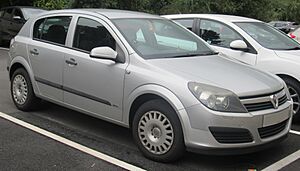
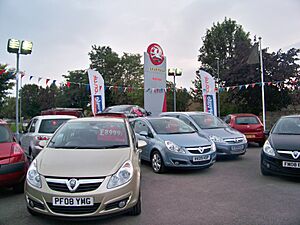
In 2002, the new Vectra went on sale, along with a large hatchback called the Signum. 2002 was one of Vauxhall's best years for sales in the UK. The Corsa was Britain's second most popular new car. The Astra was third, and the Vectra and Zafira were also very popular.
In 2003, Vauxhall Omega production ended. The Meriva mini-MPV was launched. The fifth-generation Astra, launched in early 2004, was praised for its design and became Britain's second-best selling car in 2005 and 2006. Many police forces in the UK used the Astra as their patrol car. Production of the Frontera ended in 2004.
In 2006, the third generation of the Vauxhall Corsa went on sale. This new Corsa sold much better than the previous ones and was an instant hit. The second-generation Zafira was also very popular, becoming one of the top 10 best-selling cars in the UK.
In 2007, Vauxhall released its new 4x4, the Vauxhall Antara. They also introduced the powerful VXR8 car.
In 2008, Vauxhall updated its logo. The Vauxhall Insignia was launched, replacing the Vectra, and won "European Car of the Year." Vauxhall also launched the new Agila city car.
In 2009, a new generation of the Vauxhall Astra was launched.
The 2010s
In 2010, the new Vauxhall Movano van was launched. A new Meriva also went on sale in mid-2010.
The Ampera E-Rev, an electric car with an extended range, went on sale in the UK in 2011. It won "European Car of the Year." A new Vauxhall Combo and a refreshed Corsa also went on sale in late 2011. The Zafira Tourer compact MPV was released in late 2011.
In 2012, the Vauxhall Adam city car was launched, with sales starting in early 2013. A new Vauxhall Mokka compact SUV was also launched.
In May 2012, GM announced plans to move more Astra production to the UK. They invested £125 million in the Ellesmere Port factory.
In December 2015, safety officials asked Vauxhall to recall the Zafira B model due to "improper repairs."
Joining Groupe PSA (2017–2021)
On March 6, 2017, GM and Groupe PSA announced that PSA would buy Vauxhall and Opel for €2.2 billion. This sale was completed by August 1, 2017.
On September 18, 2017, Vauxhall's official company name changed back to Vauxhall Motors Limited. On May 7, 2019, Vauxhall moved its main office from Griffin House in Luton to new offices in Chalton House.
Becoming Stellantis (2021–Present)
On January 16, 2021, Groupe PSA and Fiat Chrysler Automobiles merged to form Stellantis. In 2023, the Chalton House headquarters was taken down to make way for new industrial buildings. Vauxhall's main office in the UK is now listed as Pinley House in Coventry.
In November 2024, Stellantis announced that the Luton plant would close on March 28, 2025. All electric van production moved to Ellesmere Port. This led to the loss of up to 1,100 jobs.
Vauxhall's Current Car Lineup
Passenger Cars
Vauxhall offers a range of cars for families and individuals. Here are some of the main models:
| Model | Image | Type of Car | Body Style |
|---|---|---|---|
| Astra (Also known as Opel Astra) (Made since 1980) |
 |
Small family car |
|
| Corsa (Also known as Opel Corsa) (Made since 1993) |
 |
Supermini (small car) |
|
| Mokka (Also known as Opel Mokka) (Made since 2012) |
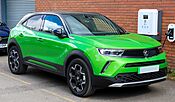 |
Small SUV (Crossover) |
|
| Grandland (Also known as Opel Grandland) (Made since 2017) |
 |
Compact SUV (Crossover) |
|
| Combo Life (Similar to Peugeot Rifter/Citroën Berlingo) (Made since 2018) |
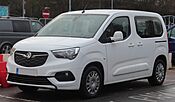 |
MPV (Multi-Purpose Vehicle) |
|
| Vivaro Life (Similar to Peugeot Traveller/Citroën SpaceTourer) (Made since 2019) |
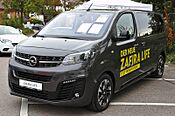 |
MPV (Multi-Purpose Vehicle) |
|
| Frontera (Also known as Opel Frontera (2024)) (Made since 2024) |
Small SUV (Crossover) |
|
Commercial Vehicles (Vans)
Vauxhall also makes vans for businesses and deliveries.
| Model | Image | Type of Vehicle | Body Style |
|---|---|---|---|
| Combo (Similar to Peugeot Partner/Citroën Berlingo) (Made since 1993) |
 |
Panel van |
|
| Movano (Similar to Fiat Ducato) (Made since 1998) |
 |
Light commercial vehicle |
|
| Vivaro (Similar to Peugeot Expert/Citroën Jumpy) (Made since 2001) |
 |
Light commercial vehicle |
|
VXR Performance Models
The VXR range was Vauxhall's line of high-performance cars. These were similar to Opel's OPC models in Europe and Holden's HSV models in Australia. VXR cars included fast hatchbacks and powerful imported cars from Australia.
The VXR badge showed off the advanced technology from the global General Motors group. Since PSA Group (now Stellantis) bought Vauxhall in 2017, the VXR brand has been put on hold.
Here are some VXR models that Vauxhall sold:
| Corsa VXR | Supermini |
|
|
| Astra VXR |  |
Small family car |
|
| Vectra VXR |  |
Large family car |
|
| Insignia VXR |  |
Large family car |
|
| VXR8 |  |
Large family car |
|
| Meriva VXR | Mini MPV |
|
|
| Zafira VXR | MPV |
|
|
| VX220 |  |
Roadster |
|
| Monaro VXR | Muscle car |
|
|
| VXR8 Maloo | Ute (pickup truck) |
|
Past Vauxhall Models
Passenger Cars
Cars designed by Vauxhall before General Motors bought them:
- 1-Cylinder (1903–1904)
- 3-Cylinder (1904–1907)
- 4-Cylinder (1905–1910)
- A-Type (1908–1915)
- B-Type (1910–1915)
- C-Type "Prince Henry" (1911–1914)
- D-type (1912–1922)
- E-type (1913–1927)
- 23–60 (1922–1925)
- 14 and 14–40 (1922–1927)
- 25–70 (1925–1927)
Cars designed after General Motors bought Vauxhall:
- 20-60 (1927–1930)
- 80 (1930–1933)
- Cadet (1931–1933)
- Light Six (1933–1939)
- Big Six (1933–1940)
- 12-4 (1937–1946)
- 10-4 (1937–1947)
- 14-6 (1939–1948)
- Wyvern (1948–1957)
- Velox (1948–1965)
- Cresta (1954–1972)
- Viscount (1966–1972)
- Cresta (1954–1972)
- Velox (1948–1965)
- Victor (1957–1978)
- VX4/90 (1961–1972, performance version of Victor)
- Ventora (1968–1978)
- Viva (1963) (1963–1979)
- Firenza (1971–1975)
- Magnum (1973–1978)
- Chevette (1975–1984, rebadged Opel Kadett)
- Belmont (1986–1991, rebadged Opel Kadett)
- Cavalier (1975–1995, rebadged Opel Ascona / Opel Manta / Opel Vectra)
- Calibra (1990–1997, rebadged Opel Calibra)
- Vectra (1995–2008, rebadged Opel Vectra)
- Signum (2003–2008, rebadged Opel Signum)
- Viceroy (1978–1982, rebadged Opel Commodore)
- Royale (1978–1983, rebadged Opel Senator / Opel Monza)
- Senator (1983–1993, rebadged Opel Senator)
- Carlton (1978–1994, rebadged Opel Rekord / Opel Omega)
- Omega (1994–2003, rebadged Opel Omega)
- Royale (1978–1983, rebadged Opel Senator / Opel Monza)
- Nova (1983–1993, rebadged Opel Corsa)
- Albany (1990–1994, rebadged Isuzu Fargo)
- Frontera (1991) (1991–2004, rebadged Isuzu MU Wizard)
- Brava (1992–2002, rebadged Isuzu Faster)
- Monterey (1994–1998, rebadged Isuzu Trooper)
- Tigra (1994) (1994–2001, rebadged Opel Tigra)
- Tigra (2004) (2004–2009, rebadged Opel Tigra)
- Sintra (1996–1999, rebadged Chevrolet Venture)
- Zafira (1999–2018, rebadged Opel Zafira)
- Agila (2000–2014, rebadged Suzuki Solio / Suzuki Splash)
- Monaro (2001–2005, rebadged Holden Monaro)
- VX220 (2001–2005, rebadged Opel Speedster)
- Meriva (2003–2017, rebadged Opel Meriva)
- Antara (2006–2015, rebadged Opel Antara)
- VXR8 (2007–2017, rebadged HSV Clubsport / HSV GTS)
- VXR8 Maloo (2008–2013, rebadged HSV Maloo)
- Insignia (2008–2022, rebadged Opel Insignia)
- Ampera (2012–2015, rebadged Chevrolet Volt)
- Cascada (2013–2018, rebadged Opel Cascada)
- Adam (2013–2019, rebadged Opel Adam)
- Viva (2015) (2015–2019, rebadged Chevrolet Spark)
Cars designed after PSA/Stellantis bought Vauxhall:
- Crossland (2017–2024, rebadged Opel Crossland)
Commercial Vehicles (Vans)
Bedford branded vehicles:
- HC (1938–1952)
- OB (1939–1951)
- M-Series (1939–1952)
- OY (1939–1953)
- S (1950–1959)
- SB (1950–1986)
- CA (1952–1969)
- TA (1953–1958)
- TJ (1958–1986)
- TK (1960–1986)
- HA (1963–1983)
- Beagle (1964–1973)
- VAL (1965–1975)
- CF (1969–1988)
- Y-Series (1971–1986)
- TM (1974–1986)
- KB (1976–1988, rebadged Isuzu Faster)
- TL (1980–1986)
- Dormobile
Vauxhall branded vehicles:
- Midi (1985–1994, rebadged Isuzu Fargo)
- Astramax (1986–1993, rebadged Opel Combo)
- Rascal (1986–1993, rebadged Suzuki Carry / Suzuki Every)
- Brava (1992–2002, rebadged Isuzu Faster)
- Arena (1997–2001, rebadged Renault Trafic)
Vauxhall's Factories and Operations
Vauxhall's main office is in Luton, Bedfordshire. It has major factories in Luton (for commercial vehicles) and Ellesmere Port (for cars).
The Luton plant currently has about 900 employees. It can produce around 100,000 vehicles. This factory makes the Vivaro light commercial van.
The Ellesmere Port plant has about 1,880 employees. It can produce around 187,000 vehicles. This factory currently makes the Astra and Astra Sports Tourer.
From 1942 to 1987, Vauxhall also had a truck and bus factory in Dunstable, Bedfordshire. This factory was built during World War II and later became a production site for Bedford Vehicles.
Vauxhall's original car factory in Luton was next to the commercial vehicle plant. After it stopped making cars in 2002, the factory was taken down. The land is now being redeveloped as Napier Park.
The Vauxhall Logo
The griffin emblem, which Vauxhall still uses, comes from the coat of arms of Falkes de Breauté. He was a soldier who received land near London in the 1200s. The house he built there was called Fulk's Hall, which later became known as Vauxhall. Vauxhall Iron Works used this emblem to show its connection to the area. When the company moved to Luton in 1905, the griffin emblem returned to its original home by chance.
The logo used to be square, but it is now round. This allows it to fit in the same space as the round Opel emblem. The griffin logo has been redesigned nine times since the 1920s. In 2008, a new version of the 2005 logo was released.
Sponsorships
Vauxhall Motors sponsored the Football Conference, a top non-league football division in England, from 1986 to 1998. In 2011, Vauxhall became the main sponsor for the national football teams of England, Northern Ireland, Scotland, and Wales.
Vauxhall in Motorsports
Vauxhall has had success in different types of car racing.
In the 1970s, Vauxhall was strong in British rallying (races on public or private roads). The Magnum coupe performed well. From 1976, Vauxhall built a special version of the Vauxhall Chevette called the Chevette HS. This car won many events in Britain and Europe. Pentti Airikkala won the British Rally Championship in a Chevette in 1979.
The Chevette was retired in 1983. The Vauxhall Astra and Vauxhall Nova were also used in races in the mid-1980s. They became popular for amateur racers because they were reliable and easy to fix.
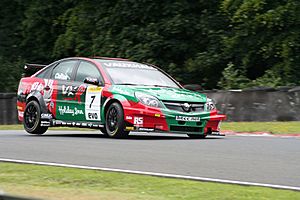
Vauxhall first entered the British Touring Car Championship (BTCC) with the Vauxhall Cavalier in 1989. Driver John Cleland won the title in 1995. The Cavalier was replaced by the Vectra in 1996.
In 2001, Vauxhall brought the Astra Coupe to the BTCC. The Astra dominated the championship from 2001 to 2004, with drivers like Jason Plato and James Thompson winning titles. Vauxhall also won the Manufacturers Award and Teams Award every year.
In 2007, Vauxhall brought the Vectra back to the BTCC. Fabrizio Giovanardi won the 2007 and 2008 BTCC championships. Vauxhall stopped its official sponsorship at the end of 2009.
In November 2016, Vauxhall announced it would return to the BTCC with Power Maxed Racing. In 2018, Senna Proctor and Josh Cook drove for the team. Senna Proctor won his first race at Brands Hatch, and Josh Cook also had wins and podium finishes. The team stayed in the top 3 in the Teams Standings all season.
For 2019, the team changed its name to Sterling Insurance with Power Maxed Racing and had two new drivers: Jason Plato and Rob Collard.
Images for kids
See also
 In Spanish: Vauxhall Motors para niños
In Spanish: Vauxhall Motors para niños


